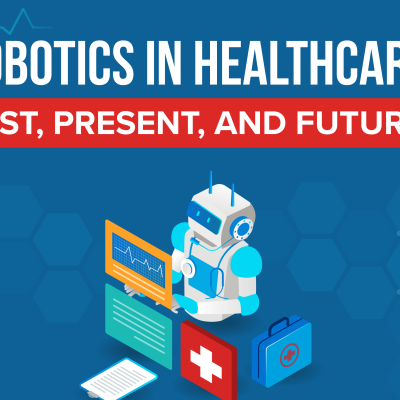- AdventHealth University
From telemedicine to artificial intelligence, robotic surgery, and 3D printing, technology is revolutionizing the healthcare industry. Today, medical professionals must be knowledgeable of these myriad innovations.
To learn more, check out the infographic below created by AdventHealth University’s Master of Healthcare Administration in Strategy and Innovation program.

Medical Device Innovations in Robotics and Imaging
The global market for medical devices is expected to reach $640.9 billion in global sales by 2023, according to Adapt Insights. This growth is driven by advancements across a wide range of fields, from robotics to nuclear medicine.
Robotic Surgical Systems
The roots of robotic surgical systems were planted in the 1970s, when NASA and the U.S. Defense Advanced Research Projects Agency (DARPA) examined the concept of remote surgery and remote telesurgery units. The surgical robots PUMA 560 and PROBOT came in 1985 and 1988, respectively, and ROBODOC was used in 1992 to prep a cavity in the femur for a hip replacement with greater efficiency compared to humans. In 2000, the da Vinci surgical system received FDA approval in the U.S. One year later, remote robotic surgery was used by two physicians in New York to remove a gallbladder from a patient in Strasbourg, France.
The benefits of robotic surgery include enabling operations to occur through minimally invasive incisions, improving surgical dexterity, and allowing for remote surgery. The drawbacks include flaws in equipment and high cost. Robotic surgery can be used in procedures like liver resection, prostate cancer surgery, and hysterectomy.
Nuclear Medicine Imaging
The concept of nuclear medicine imaging launched in 1896, when Henri Becquerel discovered uranium “rays.” A year later, Marie Curie called these rays “radioactivity.” By the 1920s, radioactive studies in animals were conducted, and therapeutic applications to treat leukemia began in 1935. The American Medical Association recognized nuclear medicine as a medical specialty in 1971; thirty years later, 16.9 million nuclear medicine procedures were performed in the U.S. Today, next-generation SPECT cameras are being used to decrease the system footprint and lower patient radiation dosage.
The benefits of nuclear medicine include its noninvasive nature, lower costs, and its ability to detect disease in its earliest stage. The drawbacks include slight pain and redness caused by an injection of the radiotracer. It can be applied to drug discovery and development and radioimmunotherapy.
Telemedicine and AR/VR
Care delivery options have expanded and offer patients the opportunity to speak with their physicians from the comfort of their homes, thanks to advancements in telemedicine.
Telemedicine
The concept of telemedicine dates to the 1920s, when radio was used to provide medical advice to clinics on ships. This medium was upgraded in the 1950s and 1960s, when patient records and radiology images were discussed via telephone. This was further expanded with the internet in the 1990s. Telemedicine as we know it today was used in the military in the 2000s, and current advances in the technology include triage bots and greater video access for patients and providers.
There are three classifications of telemedicine: remote patient monitoring, store-and-forward, and real-time. The benefits of using telemedicine include increased convenience, increased care access for rural patients, and increased productivity for providers. Drawbacks include potential fragmentation of patient records, security challenges, and subjective reimbursement policies. Telehealth’s applications include follow-up care and chronic disease management.
Augmented Reality (AR) and Virtual Reality (VR)
AR and VR innovation in the 1960s set the stage for the first commercial VR tools to roll out in the 1980s, a decade that also saw the U.S. Air Force creating the first flight simulator. By the late 2010s, AR and VR had grown to attract substantial attention from investors and the public.
The benefits of AR and VR include increased learning efficiency for healthcare professionals and increased empathy by enabling someone to see the impact of a disease or condition. The main drawback is that it’s not applicable for explaining heavy content presented in medical journals. It can be used for patient and doctor education and surgical visualization.
AI and 3D Printing
The future of the medical device market will be heavily influenced by advancements in the application of artificial intelligence and 3D printing.
Artificial Intelligence (AI)
In 1950, Alan Turing created his Turing test to see if a machine could achieve human-level performance in cognition-related tasks. By the 1980s and 1990s, AI techniques like artificial neural networks were used in clinical settings. Today, companies like Google are collaborating with health delivery networks to build prediction models.
The benefits of AI include the ability to help physicians better identify patients who need extra attention and improved care via greater personalization. The negatives include potential loss of jobs and a lack of empathy. AI can be used for online scheduling, medical record digitization, and broad applications like drug development and surgical treatment.
3D Printing
Charles Hull invented 3D printing in the early 1980s and introduced the first commercially available 3D printer in 1988. Today, advancements in the technology are being made to improve prosthetic limbs and to print medication and organs — a process called bioprinting.
The benefits include an increased ability to produce customized medical products and equipment, and enhanced productivity. Drawbacks include a current inability to bioprint complex 3D organs and a lack of clarity surrounding patient and copyright laws. Applications include creating anatomical models for surgical preparation, bioprinting, and personalized prosthetics.
Innovation for Improved Health
The intersection of technology and healthcare has led to many advancements in medical devices. To support the future of innovation, healthcare professionals will need to collaborate with researchers, developers, and leaders from a broad range of industries.


